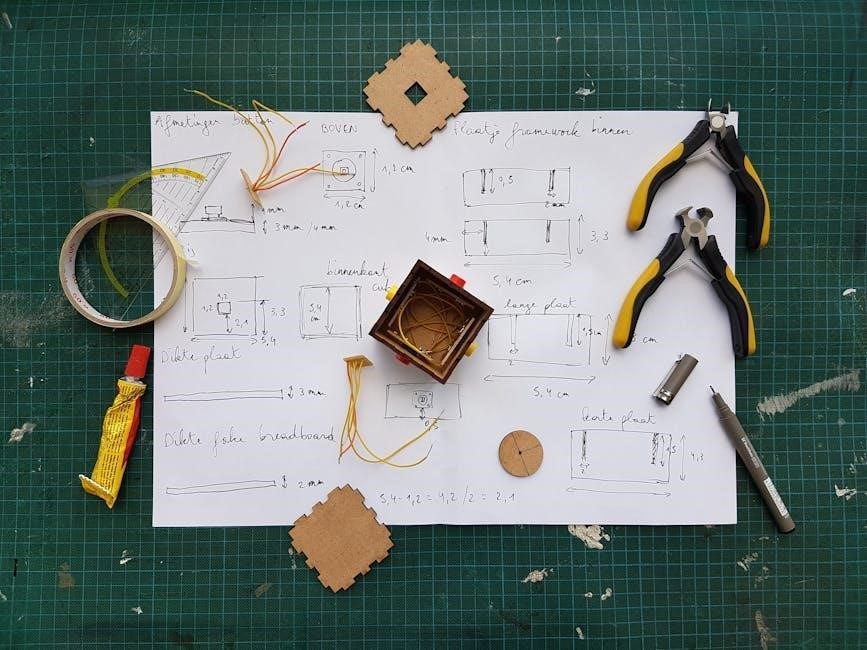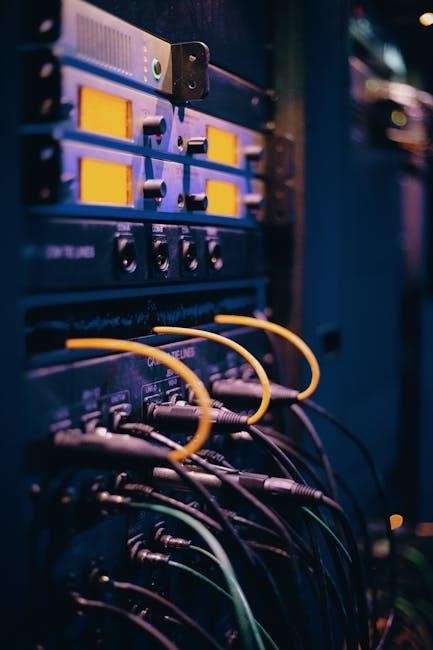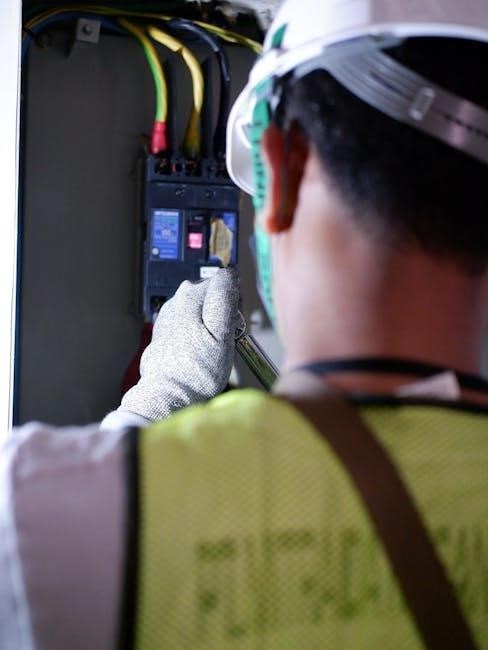3-Way Switch Wiring Diagram PDF: A Comprehensive Guide
Navigating the world of electrical wiring can be daunting, but this guide will help you understand 3-way and 4-way switch circuits. We’ll break down the diagrams and troubleshooting tips, with clear explanations and practical examples.
Understanding 3-Way Switch Basics
A 3-way switch allows you to control a light fixture from two different locations. Unlike a standard switch, a 3-way switch has three terminals: a common terminal and two traveler terminals. The common terminal is connected to either the power source or the light fixture, while the traveler terminals are connected to the corresponding terminals on the other 3-way switch.
The key to understanding a 3-way switch is the concept of “traveler” wires. These wires carry the current between the two switches, allowing you to toggle the light on or off from either location. When one switch changes position, it alters the path of the current, either completing or interrupting the circuit.
It’s important to note that the white (neutral) and bare (ground) wires are typically wire-nutted together and do not connect directly to the switch. The traveler wires connect to the brass screws, and it doesn’t matter which traveler connects to which brass screw at each switch.
3-Way Switch Wiring Diagram: Power Source at the Light
In this configuration, the power source enters the circuit at the light fixture location. A 2-wire cable runs from the power source to the light fixture, and a 3-wire cable runs from the light fixture to the first 3-way switch. Another 3-wire cable connects the first switch to the second 3-way switch.
The hot wire from the power source connects to the light fixture. The neutral wire from the power source connects to the neutral terminal on the light fixture. The 3-wire cable carries the traveler wires and a wire that connects to the common terminal of one of the 3-way switches.
This setup is common when the light fixture is located in the middle of the run between the two switch locations. It allows for easy access to the power source while still providing the necessary connections for the 3-way switch functionality.
3-Way Switch Wiring Diagram: Power Source at the Switch
When the power source enters the circuit at one of the switch locations, the wiring configuration changes slightly. In this scenario, a 2-wire cable brings the power from the source to the first 3-way switch. A 3-wire cable then runs from this switch to the second 3-way switch. Finally, a 2-wire cable connects the second switch to the light fixture.
The hot wire from the power source connects to the common terminal on the first 3-way switch. The traveler wires run between the two 3-way switches via the 3-wire cable. The 2-wire cable from the second switch carries the switched hot wire to the light fixture, along with the neutral wire.
This configuration is often used when the switch is located near the power source, making it convenient to bring the power directly to the switch box. It’s a common and practical way to wire 3-way switches in residential settings.
Wiring a 3-Way Switch with Multiple Lights
Expanding a 3-way switch circuit to control multiple lights involves replicating the wiring arrangement between each fixture. Whether the power source is at the switch or the light, the principle remains the same. The key is to ensure each light receives both a neutral connection and a switched hot connection.
When the power is at the first switch, a 3-wire cable runs to the first light. From there, two 2-wire cables connect each subsequent light. The neutral wires are spliced together, ensuring continuity to all fixtures. The switched hot wire from the last light connects to the second 3-way switch.
If the power is at the light, the hot wire is spliced to feed each light, while the neutral wire runs directly to each fixture. A 3-wire cable connects the two 3-way switches. This arrangement allows you to control multiple lights from two different locations, enhancing convenience and functionality in your home.
Wiring arrangement between fixtures
When wiring multiple light fixtures in a 3-way switch setup, the arrangement between fixtures is crucial for proper functionality. The goal is to ensure that each light receives the necessary connections to operate correctly, regardless of the switch positions. This typically involves using a combination of 2-wire and 3-wire cables to distribute power and traveler wires effectively.
The neutral wires from the power source are typically spliced together and connected to the neutral terminal of each light fixture, creating a continuous neutral path. The hot wire, however, follows a more complex route. It connects to one of the 3-way switches and then runs to the first light fixture. From there, it continues to the subsequent fixtures, often using a 2-wire cable to carry the hot wire and a neutral wire.
The traveler wires, which are essential for the 3-way switch functionality, run between the two switches, allowing the circuit to be toggled from either location. These traveler wires do not connect directly to the light fixtures; instead, they provide the necessary communication between the switches to control the lights.
Hot source connecting
In a 3-way switch circuit with multiple lights, the connection of the hot source is a critical step that determines how power is distributed throughout the system. The hot wire, carrying the electrical current, must be carefully connected to ensure each light fixture receives power and the switches can effectively control the circuit. Typically, the hot source is connected at the first switch in the series.

From the power source, the hot wire is connected to the common terminal of the first 3-way switch. This connection serves as the entry point for electricity into the switching circuit. After this connection, the hot wire is routed from the first switch to the first light fixture, initiating the power distribution to all the lights.
When connecting the hot source, it’s essential to ensure that all connections are secure and properly insulated to prevent any electrical hazards. The hot wire should never be directly connected to the neutral wires or the ground wires, as this can create a short circuit. Always use appropriate wire connectors and electrical tape to ensure the integrity and safety of the connections.
Travelers running between lights
In a 3-way switch system with multiple light fixtures, the traveler wires play a crucial role in enabling the switches to control the lights from different locations. These wires serve as pathways for the electrical signal to travel between the switches, allowing the circuit to be toggled on or off from either switch. The arrangement of these traveler wires between the lights ensures that the switching function remains consistent across all fixtures.
The traveler wires are typically run between the lights using standard electrical cables. These wires are connected to the traveler terminals on each 3-way switch. It’s important to note that the traveler wires should not be connected directly to the light fixtures themselves. Instead, they act as conduits for the switching signal, maintaining the integrity of the circuit.
When connecting the traveler wires, it’s essential to ensure that they are properly insulated and secured to prevent any short circuits or electrical hazards. By maintaining a clear and organized arrangement of the traveler wires, you can ensure that the switching function remains consistent and reliable across all light fixtures in the system.

4-Way Switch Wiring Diagram PDF: Expanding Control
Adding a 4-way switch enhances control in lighting circuits, allowing operation from three or more locations. This guide provides diagrams and explanations to understand this advanced wiring configuration.
Understanding 4-Way Switch Basics

A 4-way switch is used in conjunction with two 3-way switches to control a light fixture from three or more locations. Unlike a 3-way switch which has three terminals (excluding ground), a 4-way switch has four terminals (excluding ground), arranged in pairs. These terminals, often referred to as traveler terminals, facilitate the connection between the two 3-way switches.
The 4-way switch doesn’t directly connect to the power source or the light fixture. Instead, it acts as an intermediary, switching the connections between the travelers coming from the 3-way switches. This allows for multiple configurations, ensuring that the light can be turned on or off from any of the switch locations.
Understanding the role of the 4-way switch within the circuit is crucial for proper wiring. It is always placed between the two 3-way switches, never at the beginning or end of the circuit. The number of 4-way switches in a circuit can be increased to add even more control points, always positioned between the initial and final 3-way switches.
4-Way Switch Placement in a Circuit
The placement of a 4-way switch within a 3-way switch circuit is paramount to its proper function. A 4-way switch always resides between two 3-way switches. It’s crucial to understand that the 4-way switch doesn’t directly handle the hot wire from the power source or the wire leading to the light fixture. Instead, it manipulates the “traveler” wires that run between the 3-way switches.
Imagine the 3-way switches as the entry and exit points of a tunnel, and the 4-way switch as a switching mechanism within that tunnel. The traveler wires carry the electrical signal through this tunnel, and the 4-way switch determines which path the signal takes. This path alteration is what allows the circuit to be toggled on or off from multiple locations.
The number of 4-way switches can be extended. Each additional 4-way switch must be placed between the existing 3-way switches. This ensures the integrity of the traveler wire pathways and allows for control from multiple locations.
4-Way Switch Wiring Diagram: Multiple Lights
Wiring a 4-way switch circuit to control multiple lights involves extending the basic principles of a single-light setup. The key is to connect the lights in parallel, ensuring that each light receives the necessary voltage regardless of the state of the other lights. This is typically achieved by connecting the white wires together and the black wires together for each fixture.
The 4-way switch itself remains wired between the two 3-way switches, managing the traveler wires. The wiring between the last light and the first 3-way switch is the same as in a single-light configuration.
When connecting multiple lights, ensure all connections are secure and properly insulated. Use wire connectors appropriate for the wire gauge and the number of wires being joined. It’s also crucial to follow local electrical codes and safety guidelines to prevent hazards. Remember to turn off the power before working on any electrical circuits.
Wiring a 4-Way Dimmer Switch
Integrating a dimmer into a 4-way switch circuit adds another layer of complexity but offers the convenience of adjustable lighting. The dimmer typically replaces one of the standard 3-way switches, allowing you to control the brightness from one location while maintaining multi-location control.
The wiring involves connecting the dimmer to the common terminal and traveler wires, similar to a standard 3-way switch. The other 3-way switch and the 4-way switch remain wired as usual, managing the flow of electricity between the dimmer and the light fixture.
When selecting a dimmer for a 4-way circuit, ensure it’s compatible with the type of lights you’re using (e.g., LED, incandescent). Also, follow the manufacturer’s instructions for wiring the dimmer, as specific wiring configurations may vary. As always, prioritize safety by turning off the power before working on any electrical components.
Troubleshooting 3-Way and 4-Way Switch Circuits
When a 3-way or 4-way switch circuit malfunctions, diagnosing the problem requires a systematic approach. Begin by verifying the wiring arrangement against a reliable diagram. Incorrect wiring is a common cause of issues, especially with traveler wires or the placement of the 4-way switch.
Check for loose connections at the switch terminals and within the junction boxes. Tighten any loose screws or clamps to ensure a secure electrical path. If connections are secure, test the switches themselves for continuity using a multimeter.
A faulty switch may not conduct electricity properly, disrupting the circuit’s function. Replace any defective switches and retest the circuit. Additionally, examine the light fixtures for any signs of damage or burnout. By carefully inspecting each component and following the troubleshooting steps, you can effectively identify and resolve the problem.
Verifying the Wiring Arrangement
The first step in troubleshooting 3-way and 4-way switch circuits is meticulously verifying the wiring arrangement. Begin by consulting a reliable wiring diagram specific to your circuit configuration, noting the placement of the 3-way and any 4-way switches. Ensure that the common terminal on one 3-way switch is connected to the power source, while the common terminal on the other 3-way switch leads to the light fixture.
The traveler wires, typically connected to the brass screws on the switches, should run between the traveler terminals of the 3-way and 4-way switches. A 4-way switch must always be positioned between two 3-way switches. Double-check that no neutral wires are connected to the standard 3-way or 4-way switches, as these are only used in some smart switches or timers.
Carefully trace each wire to confirm its correct termination, paying close attention to the color coding. Any deviation from the diagram can disrupt the circuit’s operation.
Testing the Switches
If the wiring arrangement appears correct, the next step involves testing the switches themselves. Begin by disconnecting the power supply to the circuit to ensure safety. Remove the switch from the outlet box and visually inspect it for any signs of damage, such as cracks or loose terminals.
Use a continuity tester or multimeter set to the Ohms setting to check the internal functionality of the switch. For a 3-way switch, connect one probe to the common terminal and the other to one of the traveler terminals. Flip the switch toggle and observe whether the meter shows continuity in one direction and not the other. Repeat the test with the other traveler terminal.
For a 4-way switch, connect one probe to a traveler terminal in one pair and the other probe to a traveler terminal in the other pair. Flip the switch toggle and check for continuity. A properly functioning switch should exhibit continuity in one position and not the other. If any switch fails these tests, it should be replaced.


